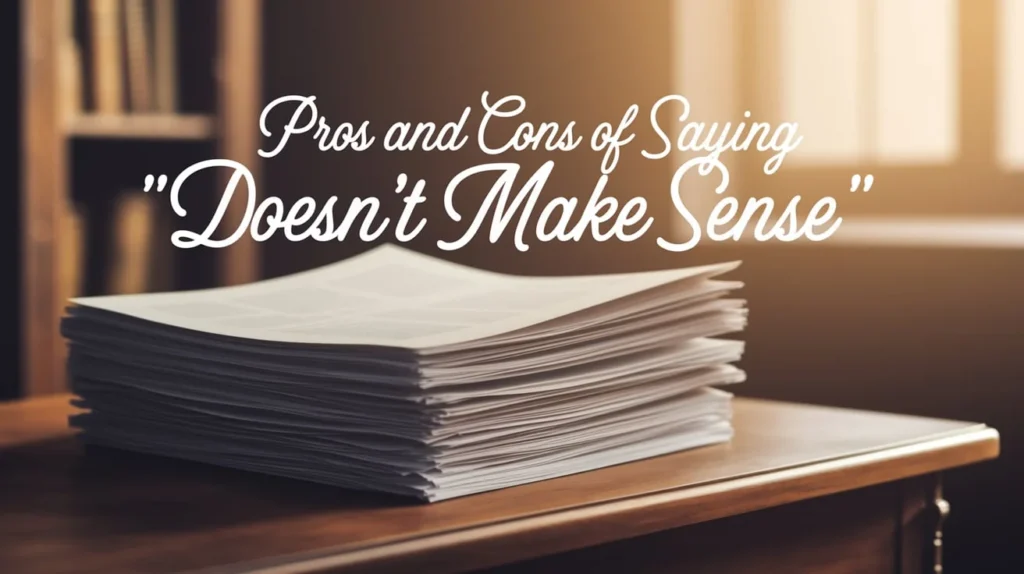When something isn’t clear or doesn’t add up, how you phrase your response can make a big difference. Choosing the right words helps keep the conversation respectful, constructive, and engaging. Instead of bluntly other ways to say, “That doesn’t make sense,” try using a more thoughtful and diplomatic alternative. Below, we explore 20 different ways to express confusion or a need for clarity while maintaining warmth and professionalism.
What Does “Doesn’t Make Sense” Mean?
The phrase “doesn’t make sense” is used when something is illogical, unclear, or contradictory. It expresses confusion or disbelief about a statement, idea, or explanation.
In professional and personal conversations, simply saying, “That doesn’t make sense,” can sometimes sound dismissive or confrontational. That’s why it’s helpful to have alternative phrases that keep the discussion open and positive.
Is It Professional/Polite to Say “Doesn’t Make Sense”?
Yes, but with caution. Saying “doesn’t make sense” can sometimes come across as blunt or dismissive, especially in emails or professional settings. It’s often better to rephrase your response in a way that invites clarification rather than shutting down the conversation.
Using a more diplomatic alternative can:
- Encourage open communication
- Avoid making the other person feel defensive
- Maintain professionalism and politeness
Pros and Cons of Saying “Doesn’t Make Sense”

Pros:
- Direct and clear – It quickly conveys confusion.
- Easy to understand – Most people will immediately know what you mean.
- Useful in informal conversations – It works fine among friends or colleagues who share a casual dynamic.
Cons:
- Can sound dismissive – It may make the speaker seem unwilling to understand.
- Lacks diplomacy – In professional or sensitive discussions, it can come across as rude.
- Might shut down discussion – Instead of encouraging clarification, it may end the conversation abruptly.
Synonyms For”Doesn’t Make Sense”
- Could you clarify that?
- I’m having trouble understanding this.
- That’s not quite clear to me.
- I see where you’re coming from, but…
- I think I might be missing something.
- Could you provide more details?
- This doesn’t fully add up for me.
- I’d appreciate a bit more explanation.
- I’m not sure I follow.
- Can you walk me through this?
- I need a bit more context to understand.
- That seems a bit unclear – could we discuss further?
- I don’t quite grasp that part.
- I may have misunderstood; could you explain again?
- Can you help me see how this fits together?
- This part seems a little confusing.
- I’d love to understand this better.
- Just to make sure we’re on the same page…
- Can you simplify that for me?
- Let’s go over this one more time.
1. Could You Clarify That?
Sometimes, a simple request for clarification is the best approach. This phrase politely invites the other person to explain further.
Scenario Example:
Subject: Clarification on Report Metrics
Hi [Name],
I appreciate the effort you put into the report. Could you clarify the section on Q3 revenue projections? I want to ensure I fully understand the assumptions behind the figures.
Thanks,
[Your Name]
Best Use:
In professional emails or meetings where you need more details.
Additional Note:
This keeps the conversation open without implying an error.
2. I’m Having Trouble Understanding This
This phrase puts the focus on your difficulty rather than the other person’s mistake, making it more diplomatic.
Scenario Example:
Subject: Need Help Understanding the Process
Hi [Name],
I’ve been reviewing the workflow changes, but I’m having trouble understanding how the new approval system integrates with our existing software. Could you walk me through it when you have a moment?
Best,
[Your Name]
Best Use:
When you want to express confusion without sounding critical.
Additional Note:
This works well in teamwork situations where you need help.
3. That’s Not Quite Clear to Me
This phrase politely signals confusion and encourages further explanation.
Scenario Example:
Subject: Questions About Client Request
Hi [Name],
I was going through the client’s email, but that’s not quite clear to me. Are they asking for a complete redesign or just minor adjustments?
Thanks,
[Your Name]
Best Use:
In professional or customer-service-related discussions.
Additional Note:
Adds a neutral, non-confrontational tone.
4. I See Where You’re Coming From, But…
Acknowledging the other person’s perspective before questioning something makes the conversation smoother.
Scenario Example:
Subject: Regarding Marketing Strategy
Hi [Name],
I see where you’re coming from, but I’m unsure how this approach will impact engagement rates. Can we discuss this in more detail?
Best,
[Your Name]
Best Use:
When you want to disagree respectfully.
Additional Note:
Softens potential criticism.
5. I Think I Might Be Missing Something
This phrase suggests that the misunderstanding is on your end rather than blaming the other person.
Scenario Example:
Subject: Project Timelines
Hi [Name],
I was reviewing the timeline, and I think I might be missing something. Could you clarify how the deadline aligns with the resource availability?
Thanks,
[Your Name]
Best Use:
When you want to request clarification humbly.
Additional Note:
Keeps the conversation friendly and open.
6. Could You Provide More Details?
Instead of stating that something “doesn’t make sense,” this phrase invites additional information.
Scenario Example:
Subject: Clarification Needed on Project Outline
Hi [Name],
I appreciate the effort you put into the project outline. Could you provide more details on the timeline and key deliverables? I want to ensure we’re aligned before moving forward.
Thanks,
[Your Name]
Best Use:
When requesting more information in a professional setting.
Additional Note:
This keeps the tone neutral and encourages explanation.
7. This Doesn’t Fully Add Up for Me
This phrase suggests that something seems incomplete or inconsistent rather than outright wrong.
Scenario Example:
Subject: Question on Budget Allocation
Hi [Name],
I was reviewing the budget proposal, and this doesn’t fully add up for me. Could you clarify the breakdown of expenses?
Best,
[Your Name]
Best Use:
When discussing numbers, data, or logic-based topics.
Additional Note:
Keeps the conversation constructive rather than critical.
8. I’d Appreciate a Bit More Explanation
This phrase politely signals that you need more clarity.
Scenario Example:
Subject: Need More Context on Client Feedback
Hi [Name],
I read through the client’s response, but I’d appreciate a bit more explanation on their concerns regarding the product features. Do you have more insights?
Thanks,
[Your Name]
Best Use:
When seeking additional insights in a professional or customer service setting.
Additional Note:
Shows openness to understanding without implying an error.
9. I’m Not Sure I Follow
This phrase conveys confusion in a way that invites further clarification.
Scenario Example:
Subject: Re: Process Update
Hi [Name],
Thanks for sharing the updated process. I’m not sure I follow the new approval steps. Could you walk me through them?
Best,
[Your Name]
Best Use:
When needing a more detailed explanation.
Additional Note:
Works well in both formal and informal discussions.
10. Can You Walk Me Through This?
Asking someone to “walk you through” something makes the request feel more collaborative.
Scenario Example:
Subject: Understanding the New Software Integration
Hi [Name],
The new integration looks great, but can you walk me through how the API connects with our database? I’d love to understand the process better.
Thanks,
[Your Name]
Best Use:
When learning a new process or system.
Additional Note:
Sounds engaged and interested rather than confused.
11. I Need a Bit More Context to Understand
This phrase highlights that you require more background information.
Scenario Example:
Subject: Client Inquiry on Pricing
Hi [Name],
Before responding to the client, I need a bit more context to understand their pricing concerns. Do we have past correspondence on this?
Thanks,
[Your Name]
Best Use:
When seeking background information.
Additional Note:
Adds a layer of professionalism while avoiding confusion.
12. That Seems a Bit Unclear – Could We Discuss Further?
This phrase keeps the conversation open and invites discussion.
Scenario Example:
Subject: Reviewing the Proposal
Hi [Name],
I went through the proposal, but that seems a bit unclear – could we discuss it further? I want to ensure we address all client needs.
Best,
[Your Name]
Best Use:
When requesting further discussion in a collaborative setting.
Additional Note:
Encourages dialogue rather than disagreement.
13. I Don’t Quite Grasp That Part
Sometimes, you understand most of the conversation but struggle with a specific point. This phrase allows you to highlight where the confusion lies while inviting clarification.
Scenario Example:
Subject: Clarification on Marketing Strategy
Hi [Name],
Thanks for the update on the marketing plan. I don’t quite grasp that part about reallocating the budget to social media ads. Could you provide more details on the reasoning behind that decision?
Looking forward to your insights.
Best,
[Your Name]
Best Use:
When seeking clarification on a specific section of information.
Additional Note:
This phrase reassures the other person that you’re engaged but need extra clarity.
14. I May Have Misunderstood; Could You Explain Again?
This phrase softens the request for clarification by taking responsibility for a possible misunderstanding.
Scenario Example:
Subject: Need More Info on Project Deadlines
Hi [Name],
I want to make sure I’m on track with the timeline. I may have misunderstood; could you explain again how the milestone deadlines are structured?
Thanks for your patience!
Best,
[Your Name]
Best Use:
When you want to clarify information without implying that the other person was unclear.
Additional Note:
This is an excellent way to keep discussions constructive and positive.
15. Can You Help Me See How This Fits Together?
If you’re struggling to connect different parts of an idea, this phrase is a great way to ask for clarification while keeping the conversation collaborative.
Scenario Example:
Subject: Aligning the Team’s Goals
Hi [Name],
I see the proposed changes in the workflow, but can you help me see how this fits together with our existing processes? I want to make sure we transition smoothly.
Looking forward to your thoughts.
Best,
[Your Name]
Best Use:
When trying to understand how different elements relate to each other.
Additional Note:
This phrase makes you sound engaged and thoughtful rather than confused.
16. This Part Seems a Little Confusing
If only one part of an explanation doesn’t make sense, this phrase helps pinpoint the issue.
Scenario Example:
Subject: Question About Financial Report
Hi [Name],
I went through the financial report, and this part seems a little confusing – specifically the calculations for projected revenue. Could we review that section together?
Thanks,
[Your Name]
Best Use:
When addressing a specific point that needs clarification.
Additional Note:
This phrase keeps the conversation open-ended rather than critical.
17. I’d Love to Understand This Better
This phrase expresses curiosity and willingness to learn rather than just pointing out confusion.
Scenario Example:
Subject: Understanding the New Policy Update
Hi [Name],
The new policy update sounds interesting! I’d love to understand this better – could you share more details on how it affects our daily workflow?
Thanks in advance!
Best,
[Your Name]
Best Use:
When showing enthusiasm about learning more.
Additional Note:
This is a great way to encourage a more in-depth explanation while keeping the tone positive.
18. Just to Make Sure We’re on the Same Page…
This phrase ensures alignment rather than implying confusion.
Scenario Example:
Subject: Verifying the Next Steps for the Project
Hi [Name],
Just to make sure we’re on the same page, we’re finalizing the draft by Friday and sending it for approval next Monday, correct?
Let me know if I missed anything!
Best,
[Your Name]
Best Use:
When confirming details to avoid miscommunication.
Additional Note:
This is a polite way to ask for verification while keeping the conversation productive.
19. Can You Simplify That for Me?
When something is too complex, asking for a simpler explanation helps clarify things without making the other person feel like they were unclear.
Scenario Example:
Subject: Understanding Technical Specifications
Hi [Name],
The specs look great, but can you simplify that for me, especially the integration part? I want to make sure I understand it fully before we move forward.
Thanks!
Best,
[Your Name]
Best Use:
When dealing with highly technical or complex topics.
Additional Note:
This phrase helps break down complicated concepts without making it seem like you weren’t paying attention.
20. Let’s Go Over This One More Time
If you need a full recap, this phrase lets you request it respectfully and collaboratively.
Scenario Example:
Subject: Reviewing Project Deliverables
Hi [Name],
Before we finalize everything, let’s go over this one more time to ensure we’ve covered all key points. Would you be available for a quick meeting tomorrow?
Best,
[Your Name]
Best Use:
When reviewing important information before taking action.
Additional Note:
This phrase is particularly useful in team discussions and final checks before decisions.
Conclusion
Choosing the right words when something “doesn’t make sense” can make a significant difference in communication. By using more thoughtful phrases, you keep conversations open, constructive, and professional. Whether you’re in a business meeting, emailing a client, or discussing something with a colleague, the way you express confusion matters.















